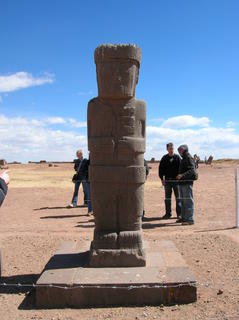Things I learned while in Bolivia:
1) tons of Bolivian slang (including some Aymara and Quechua words)
2) what real development is all about (change of beliefs and traditions) and how hard the real development work is
3) how awesome fruit and vegetables grown without chemicals can taste
4) that I absolutely love steak
5) how to tell apart llama, alpaca, and vicuna
6) that there are Russians in every corner of this planet
7) how to survive in a fairly cold climate
8) what real Christian hospitality and kindness are like
9) that my favorite method of public transportation is definitely the train
10) that I ABSOLUTELY love to travel!!!
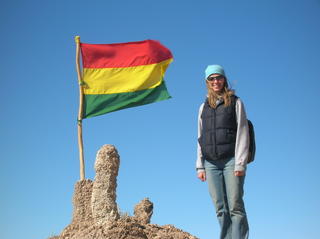
Last Day
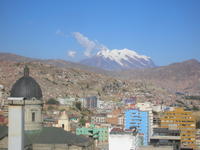
I started getting a little teary eyed the day before, on the train, looking out of the window on the unforgettable altiplano and the mountains and realizing that I wasn’t going to see this scenery anymore. Good thing that the last day was very busy…the three of us (Sara, Meg, and I) left the house early to finish some last minute shopping, introduce Meg to saltenas (typical Bolivian food), and to tour the beautiful church of San Francisco, which turned out to be a very enlightening tour during which I learned a lot about the history of Bolivia, La Paz, and the Catholic Church in Latin America. Souvenir shopping was quick and crazy (soooo much stuff to choose from), and packing was even worse (why do I always bring so much stuff when I travel???) At night we hung out the family, ate pizza, and took some last-minute pictures, battling with the self-timer function on my camera. After sleeping about 2 hours, we left at 4am for the airport, and about 7am our plane got in the air, leaving the beautiful country that I grew to love behind.(The pictures are of the view of La Paz and Illimani (the mountain) from a overlook platform at a hotel and of the family I stayed with).
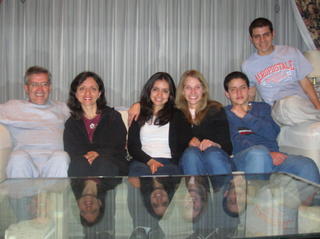
Salar de Uyuni (contd)
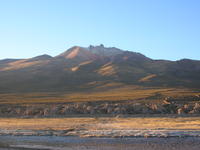
Thursday/Friday
Waking up at the crack of dawn and eating yet another delicious breakfast, prepared by our guide’s wife, we first went to see some interesting mummies left almost untouched from the pre-Inca times and then embarked on a strenuous hike to the mid-section of the volcano Tunupa…let me tell you, considering it was already in very high altitudes with wind and bright sun, it really took some effort to complete this hour and a half climb…upon reaching an overlook place, we were rewarded for our efforts by a gorgeous and tranquil view of the volcano and the surrounding valley ( and we also saw some llamas on the way there, which was my last chance to be close to them and try petting them that is almost impossible since they are very timid). Needless to say, the walk back took us twice less the time it took us to climb up and after lunch, we began our journey back to Uyuni. On the way we saw some more of the Salar, got to see how salt is processed, toured the Hotel del Sal (hotel made completely of salt), and visited the Ojos del Sal (“eyes of the salt,” holes in the middle of the salt field with bubbling water caused by the water pressure of the rivers underneath the surface). Near Uyuni, we also visited the “Cementerio de Trenes,” a place with tons of old locomotives.
Oh but the “best part” was yet to come…we were supposed to leave on the train back to Oruro at around 1:30 am Friday morning…we showered and rested a bit at the hotel, packed our bags, checked out of the hotel, and walked to the train station at around 1am. When we got there, there were surprisingly very few people, and an Argentinian couple sadly told us, “No hay tren,” which simply means, “there is no train.” It turned out that due to some mechanical problems, the train was delayed till 9:00am or so the next morning. Dumbfounded, we opted to return to the hotel and sleep there for a few hours before returning to the station. After a night of nightmares of missing the train, we woke up early the next morning to ensure us getting on that train if it came any earlier…We did get on it, but not until 11am. Even though I was exhausted, I realized that this was my last chance to see the beautiful altiplano, with its unique scenery and, of course, the llamas, so I stayed awake most of the train ride gazing out of the window and taking a million pictures of the surroundings.
Right off the train in Oruro, we were greeted by frantic cab drivers telling us that there was a road blockade between Oruro and La Paz and that we better hurry if we want to make it to the last bus leaving for La Paz. The prospect of spending a night in this sad and quite detestable town really scared us, so we jumped in the first taxi, and even though the driver drove like a maniac, we did make it to the only bus leaving for La Paz. To our great relief, the road blockade has disseminated by then, and about 3.5 hours later, we were picked up by Sara’s parents and in about 30 more minutes we were finally HOME! (The pictures are of the volcano from the top and me at the overlook, and the girls sitting on a plaza in Uyuni waiting for the train).
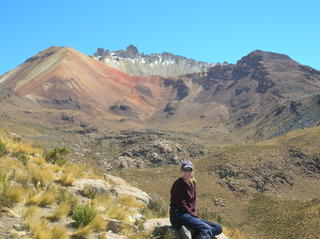
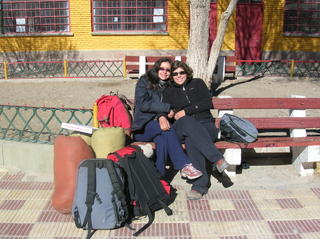
Salar de Uyuni (contd)
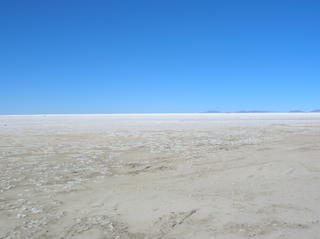
Wednesday
In the morning after having breakfast with the most delicious bread I have ever had (called el pan del pueblo), we were picked up by our tour guide in a 4x4 Toyota SUV and along with a French couple, embarked on our journey to the Salar. On the way there, I finally saw some vicuñas, the third camelid found in Bolivia…they were very different from llamas and alpacas…skinnier and with longer neck. This animal has not been domesticated and lives in the wild, but is protected by the Bolivian government.
The Salar was truly an incredible sight…it looked like a huge white sea or the Arctic…everywhere you looked, there was salt surrounded by mountains. This is the largest salt deposit in the world…it stretches for 12,000 square km…Bolivians export salt to several neighboring countries. It was interesting to learn that only the people from the small town of Colchani, located on one “shore” of Salar have the right to work there…they gather the salt into small piles, transport it back to the town, grind it, add iodine, package it, and ship it out.
Our next stop was Incahuasi (or La Isla del Pescado), a coral-like reef right in the salt field that from far away looks like a giant fish. The most unique thing was that the island was completely covered in giant cacti…we could barely believe our eyes. We walked to the top of the island to enjoy an incredible view of the salar, and then ate a delicious lunch prepared by our guide’s wife right there on the island.
After lunch we went to a very unique cave called Galaxy discovered only 3 years ago by Italian archeologists looking for pre-Incan mummies…the inside was composed of dried-up volcanic ash that took very unusual shapes. The next stop just next door was to the Cementerio de Chulpas (mummy cementery), except that either the indigenous people hid their dead from the Spaniards or the Spaniards stole all the mummies (since people were usually buried with most of their earthly possessions).
Then we headed off to our final destination that day…a small village at the feet of Volcano Tunupa, also located in the salar. Right upon the entrance, we saw another breathtaking sight…flamingos, lots of them, just hanging out at the water puddles in the salar…it was unbelievable to see such an exotic bird, which I always associated with tropical parts of Florida, right there, in the midst of the cold salt field. The next pleasant surprise was seeing lots of llamas at the entrance to our lodgings. The unpleasant surprise that followed was discovering how humble our accommodations were..we barely had a roof and no running water and electricity by generator (mind you, we were in the midst of the cold altiplano). Well, cheered up a little by Meg and Sara, I decided that I could indeed survive one night there, and took advantage of the remaining daylight to try to get close to the llamas and flamingos, both of which I succeeded in doing and got some great pictures. After dinner, we discovered that we only had light till 9pm, but actually weren’t as cold as I imagined when we went to bed in the anticipation of new exciting adventures. (The pictures are of the Salar, the three of us standing on a pile of salt, and flamingos)
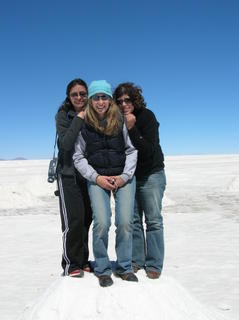

Salar de Uyuni
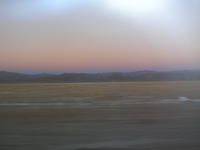
Tuesday
Sara, Meg, and I got on the bus to Oruro, a sad miner’s town that I have visited earlier in the summer (3 hours south of La Paz) to take a train to the department of Potosi to the small town of Uyuni where the Salar (large salt field) is. The train ride was rather comfortable even though it was 7 hours long. We saw the magnificent Andes mountains and the flora of the altiplano and also got a chance to see Lake Poopo, the second largest lake in Bolivia. Upon arrival to Uyuni, we went to our hotel, which was right across the train station and went straight to bed. It was rather cold in this town as it is located in one of the coldest areas in Bolivia, so we had to get into our sleeping bags underneath the bed covers. (the pictures are of the altiplano at dusk (above) and of Lake Poopo (below).
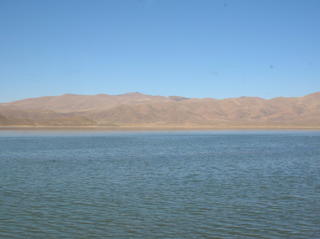
Trip to Peru (contd)
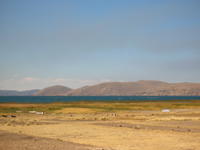 Travelling the Latin American style (Monday):
Travelling the Latin American style (Monday):In order for Meg to see Lake Titicaca, we chose to travel back to Bolivia on the ground, i.e. by bus.The trip started with a 6-hour leg from Cusco to Puno on a fairly nice bus filled with tourists like us (the bus had a TV, a bathroom, and a snack service).Once in Puno, a town on the lake, we had to get on another bus going to Desaguadero, a border town on the Bolivian side.This bus was small uncomfortable where we got stuck on the back row crammed in between several other passengers.About 15 minutes into the journey, the bus got a flat tire...unfortunately, the bus driver didn't have the necessary instruments or the tire (I couldn't understand which one he lacked in the disgruntled conversations of other passengers).Several people got off the bus and crammed themselves into other buses going in the same direction...Meg and I chose to stay and wait and were rewarded when the tire finally got replaced (about 45 min later) and we were able to get better seats. Besides, most of this part of our trip was along the shores of the magnificent Lake Titicaca (even though the Peruvian side of it is not as pretty as the Bolivian side, but maybe Im just biased). I was also happy to see more of the altiplano with beautiful mountains against clear blue sky and fields with all sorts of farm animals including my beloved camelids represented here mostly by alpacas.
In about 2.5 hours we reached the Peruvian-Bolivian border, went through both checkpoints, and once on the Bolivian side, in Desaguadero, climbed into a Toyota minivan that took us on a two-hour trip back to La Paz (as you can guess, our travelling conditions got worse and worse with each leg of the journey).
Anyway, 3 buses and 13 hours of travelling later, we are back to our house in La Paz and packing for our trip to Salar de Uyuni tomorrow.
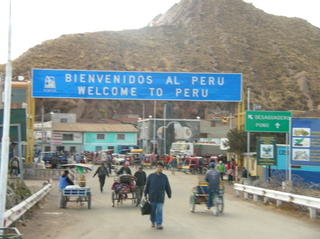
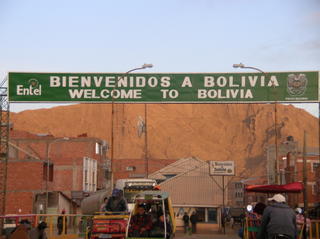
Trip to Peru (contd)
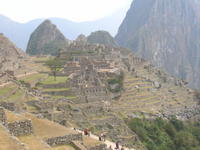 Machu Picchu (Sunday):
Machu Picchu (Sunday):Finally, the long-awaited day arrived...at 6am, Meg and I boarded a train that took us on a 4-hour long trip to Aguas Calientes.There I was pleasantly surprised to discover that Machu Picchu was located in the semi-tropical zone, which guaranteed a warm day.From there, we had to take a 30-minute bus ride to the actual park along a winding mountain road, which offered not only a breathtaking view of the mountains, but also gave us a peak of the ruins...even from a distance, the ruins looked impressive.
And indeed, Machu Picchu proved to be more that I expected...a whole city of ruins, well-preserved, with tons of interesting history and mistery behind each stone.We decided to forego getting a guide and explore the ruins on our own with the help of a map that showed us all possible tracks.
Our misfortunes began when we, busy taking in the majesty of the ruins and taking pictures, accidentally took a wrong turn and got off the intended track.We found ourselves more and more lost as we went on (by lost I mean being surrounded by ruins, but not knowing what they meant).Our miseries climaxed when we climbed up to a group of ruins, which we later learned was former Inca industrial zone, and found ourselves not being able to climb back down and even getting whistled at by one of the park workers warning us against any kind of mischief (such as jumping off the ruins).Once we found our way back down, we ended up talking to the same worker that whistled at us and learning all sorts of interesting things about the ruins and history behind some of the areas.
FYI: Machu Picchu, or the Hidden City of the Incas, was discovered sometime in the first half of the 20th century by an English (or maybe American) explorer Hiram Bingham who gave the place its current name and named the groups of ruins in it.We were also surprised to find out that Machu Picchu is actually the name of one of the mountains surrounding the park and was given to Bingham by the locals when he first arrived there.In Quechua it means Old Mountain...on the other side of the ruins, there is a mountain called Hyana Picchu, or Young Mountain.
Based on the history and details of the ruins, Machu Picchu (the park) used to the an important religious site for the Inca Empire. The Incas had a calendar of 365 days and were able to tell seasons of the year.Their civilization was very advanced, and their religious beliefs were based on astronomy and the objects of nature around them (water, mountains, etc).
We were also lucky to see some more of my beloved llamas just walking around the ruins...I was glad that Meg got to pet one. The train ride back to Cusco was very enjoyable as our attendants put on a costume show displaying the clothes made out of the fiber of baby alpaca.
The picture above is of the view of the park, and below are some shots of Meg and I among the ruins.
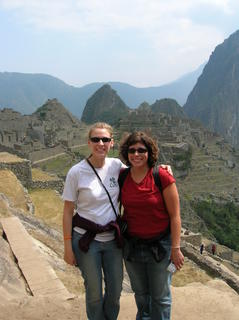
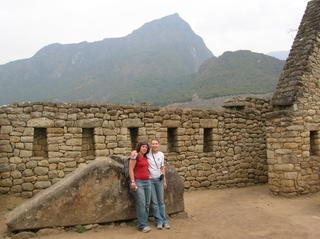
Long-awaited trip to Peru
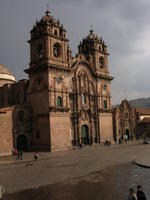 Cusco (Saturday):
Cusco (Saturday): Meg and I got up bright and early and got on a plane to Cusco, Peru.We were picked up by our hotel owner and taken first to the Perurail office to buy our train ticket to Macchu Pichu, then to the hotel to drop off our things, and then to Cusco downtown to begin our Peruvian adventures.
Cusco is a very historic, beautiful and definitely unique place.It is very different from La Paz as it has more evidences of the Spanish colonial presence...many cobblestone roads, churches and cathedrals of a different style that in Bolivia (more of a colonial Baroque style), and typical Spanish-style houses with courtyards inside (see picture below).After eating a delicious lunch of alpaca steak, we embarked on a trip to the nearest Inca ruins, the names of which I wouldn't be able to pronounce.We walked around the ruins, sat on the Inca throne,got soaked in the rain and hail on the way to the other ruins (named Q'enko), where we did some cave exploring, and then returned to the city.
There we toured around the magnificent Catedral with amazing paintings and carvings inside.Then we went to another very interesting place called Qoricancha/Convento de Santo Domingo, which combines an ancient Inca temple with a Catholic convent built on top of it.The ruins of the Inca infrastructure are still there side by side with the Catholic structures.After this tour, we rushed off to another interesting church called the Iglesia de San Blas (church of Saint Blaise), where the paintings on the walls told us the story of this saint, who lived in the third century and was a throat doctor as well as an avid defender of Catholic faith.He was later captured and beheaded by the Romans.The barrio (neighborhood) of San Blas has narrow cobblestone streets and is famous for its abundance of artesan shops.There, Meg and I did some shopping and then rushed off to see a performance of traditional peruvian dance and music.
The picture above is of the Cusco cathedral, and below are the view of Cuzco from the ruins and of Meg and me sitting on the Inca throne.
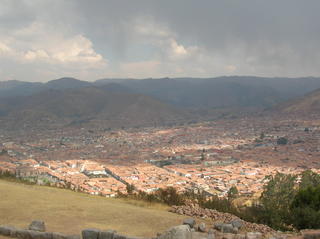
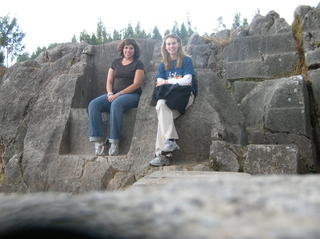
A week at a glance
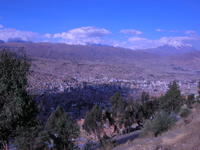
Well, this was my last week of work, except that I decided to be sick again and stayed in bed most of the week.I did finish all my research projects on Monday and got good reports from my boss about my work. Im beginning to realize that I only have a little more than a week left here in Bolivia, which makes me very sad.The good-byes have already started.
Things I will miss the most about being here:-cheap and easy public transportation (once you figure it out)
-being called reinita, hermosa, querida, etc (on the street and among friends)
-having a maid who cooks delicious lunches and makes your bed for you when you leave in a hurry in the morning
-being surrounded by beautiful mountains everywhere you look
-clear blue sky everyday
-having a sister/friend my age very similar to me in character and preferences
-incredibly delicious bread and meat and amazingly fresh vegetables and fruit (including freshly squeezed fruit juice every morning)
-big family lunches after church on Sundays where the whole family gets together
Things still to look forward to:-My friend Meg (from grad school)coming on Friday
-trip to Peru (Cusco and Macchu Pichu) over the weekend
-trip to the Salar de Uyuni after Peru
-one more glance at the magnificent Lake Titicaca
-souvernir shopping
-finally being warm and sweating again (back in DC)
Finally (aka Lake Titicaca and Isla del Sol)
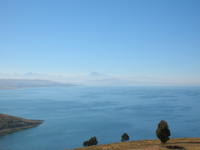
I FINALLY got to see the one place in Bolivia that I have read about and dreamed about seeing...the majestic Lake Titicaca.On Saturday, the Rodriguez (my host family) and I drove down to Copacabana, a small town on the shores of the Lake to see this magnificent creation of God...and everything I read about this place is true...it is absolutely breathtaking, with amazingly blue water and mountains surrounding it.
A little bit of history/geography: Lake Titicaca is the highest navigable lake in the world.The reason for the water being so blue (in places sky-blue) is because it reflects the sky.Part of if belongs to Bolivia and part to Peru.It is so large that it really resembles a sea and even smells like the ocean, even though the water is not salty.The Lake has an important significance for the Bolivians as the legend says that the Incan civilization was born on the Isla del Sol (the Sun Island that is located in the Lake, on the Bolivian part).Supposedly, the children of the sun god went there and became the forefathers of the Incas.The Lake has become deeper with the centuries and has covered many unique Incan ruins.Some still remain on the Isla del Sol.
One of the highlights of the trip was definitely going to the Isla del Sol, about an hour and a half boat ride with incredible view.We only had an hour on the island, and since we wanted to see some sights, we had to climb up hundreds of steps made by the Incas (I think called Camino del Inca) and up the pathway to cross over to the other side of the island to see the Peruvian side of the Lake.The parents didn't want to climb up all the way, but Sara and I had to literally run up to see the other side and then run down to make sure we catch the boat back to Copacabana.Keeping in mind that we were climbing up in the altitude of 4000 meters above sea level, my heart was literally jumping out.
Once back in Copacabana, we went to the famous church of the Virgen of Copacabana, which attracts thousands of Bolivian and Peruvian pilgrims every year. The whole altar was covered with gold and silver, and there was a museum of all the things that people bring as gifts to the Virgin of Copacabana.
Some more adventures Bolivian style on the way back...to get to Copacabana, you have to cross a straight in a little boat (the car crosses on another ferry-type boat).Well, on the way back in the dark the boat engine died in the middle of the lake...it probably got filled with water...the driver tried to start it for about 10 minutes, but all in vain...well, two other boats came and began towing us to the other side...then our engine started again and we were going on our own for a while, but then it died again very close to the shore, and the wind started drifting us back to the other side...another boat came and literally pushed us to the dock (btw, if you thought this story was never going to end, so did I sitting in that boat in the cold and dark thinking we were never going to cross this tiny stretch).
The pictures below are of me and Sara with the view from the Isla del Sol of the Bolivian side of the Lake, and of me with the view from the island of the Peruvian side.The amazing thing was being able to see the Cordillera (mountains) ad my favorite peak, the Illimani, from the Isla del Sol (in the background of the Bolivian side of the Lake).
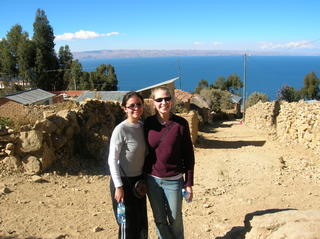
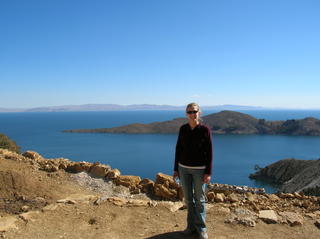
A week at a glance
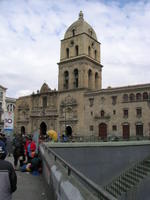
Last week was pretty uneventful (well, compared to the others)...I finally worked another full week without travelling and enjoyed hanging out with Sara and the rest of the family.Even though my general rule is not to share bad things on this blog, I think that I will break that rule since it's the only news I've got. So 2 not-so-great things happened last week, but the Lord has definitely provided and took care of me.
1) My computer got a horrible virus and was completely unusable.After the initial freaking out, I was surprisingly doing well about it.Those who know me well are aware how much Im attached to my computer, so that was supposed to be pretty devastating for me, but the Lord gave me lots of peace and by His mercy, the computer got fixed with no data loss.
2) I can now consider myself a full Bolivian because I got salmonella...Apparently, it is a very common thing to get here and no one really worries about it.I'm taking antibiotics, but the thing that saddens me most is that I have to maintain a diet to get better, and it has been very hard because I really like the food here.
On Sunday, Sara and I continued our tour of La Paz by visiting several Catholic churches around town.Some of them are very old (like the Iglesia de San Francisco in the picture that dates back to 1548), but all of them are different inside.It was interesting to see how the Catholic beliefs are so intermixed with the indigenous religions. The picture below is of me at the main plaza in La Paz called Plaza Murillo, with the Governmental Palace and the main Cathedral in the background.
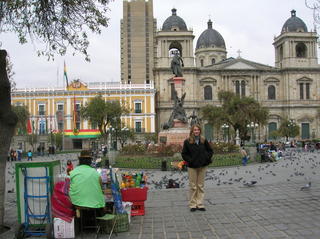
Entrada Universitaria (Celebration of the beginning of the new semester)

On Saturday, Sara (my host sister) and I went to the La Paz uptown (central area) and visited some museums.It was very interesting to learn more about Bolivia´s independence war and the history of the Ancient Indian civilizations that lived in the Andes before the arrival of the Spaniards.The one that was probably the most interesting was the museum dedicated entirely to the Litoral (the Bolivian province that was lost to the Chileans along with the access to the sea, which I have mentioned in one of my previous entries).It was obvious that the Bolivians are still very angry at the Chileans, and I definitely learned the reason why:the Chileans invaded this province and claimed it as their own once its riches (gold, huano) were discovered, thus breaking several treaties made with Bolivia.
Saturday was also another holiday in La Paz, called Entrada Universitaria, which celebrates the beginning of a new spring semester.All the departments of the numerous universities in La Paz rehearse traditional Bolivian dances and perform them in the city streets.It was definitely very interesting to learn more about the Bolivian culture and witness this celebration full of music, colorful costumes, and beautiful dances.The pictures below are of 2 typical Bolivian folk dances.
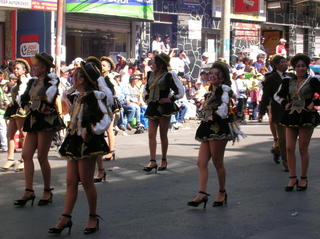
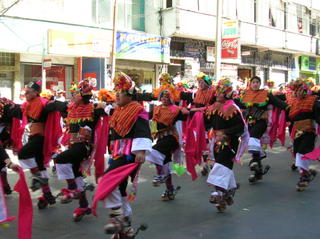
Coroico
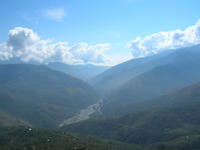
I spent Wednesday and Thursday of last week in the beautiful Coroico, a small town across the mountain range from La Paz with subtropical climate, which meant warm weather and short sleeves.I was there with the team from my church in MD (Covenant Life Church) and several people from the church here in La Paz.To get there, you have to travel along the Camino de Muerte (Road of Death), a narrow winding rocky mountain road.We stayed in an adorable quaint hotel (without hot water though)overlooking a mountain range and a valley that was filled with clouds in the mornings.I have never seen a sight like that before.We went to a waterfall, walked around the city, and of course, had fireworks (that seems to be the most common thing to do here for fun since it´s legal). The best part was getting to know the people from Covenant Life and serve together by painting a small local church.I had no idea how much detail was involved in painting, but now I feel like I can paint.
(The picture below is of me and Jen Wahl, a girl from my care group (Bible-study)at Covenant Life, by the waterfall)
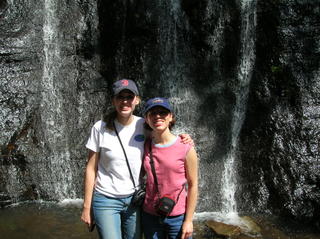
Tiwanaku (Ancient Incan Ruins)

The team from my church in Gaithersburg, Maryland is here in La Paz on a missions trip, helping in the church here, doing evangelism, and ministering in various other places.With them, I had a chance to visit the ruins of an important religious site of the ancient Inca civilization (400BC-about 1200AD), which stretched from Northern Chile, all over Peru, the Bolivian Altiplano, and even Northern Argentina and Southern Ecuador. It was very interesting to see what a high level of development the Incas had reached; from the ruins of their temples and the remains of their culture, it was evident that they had progressed in engineering, mathematics, astronomy, and architecture.They lived by three principles and always used them to greet each other:
~Don't steal
~Don't kill
~Don't be lazy
The Incas lived in constant expectation that something big would happen to them (according to their astrological predictions), and that is why when the Spaniards, white men on horses with guns,came, the Incas thought that they were gods and welcomed them into their cities, resulting in 120 Spaniards overtaking almost the entire Inca empire (I think I remember this correctly).
On the way back, we had a lot of fun sharing our testimonies and laughing at each other.It was amazing to see how God has put such different people together on this team and to hear about the evidences of God's grace in their lives.
